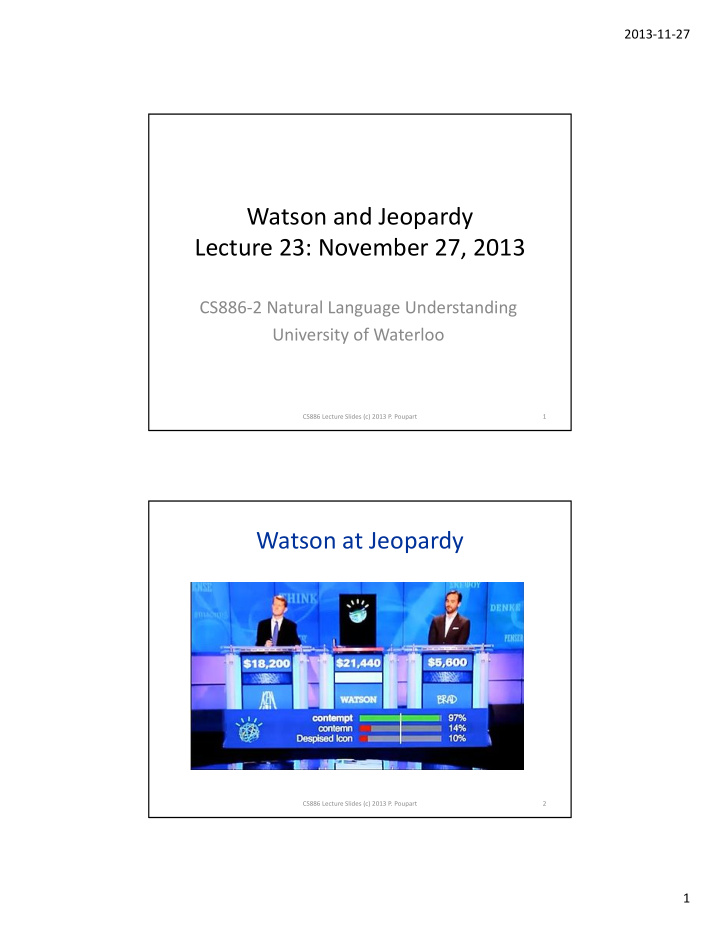



2013 ‐ 11 ‐ 27 Watson and Jeopardy Lecture 23: November 27, 2013 CS886 ‐ 2 Natural Language Understanding University of Waterloo CS886 Lecture Slides (c) 2013 P. Poupart 1 Watson at Jeopardy CS886 Lecture Slides (c) 2013 P. Poupart 2 1
2013 ‐ 11 ‐ 27 Jeopardy • Host reads a clue in the form of an answer – But it is really a question • Contestants respond with a question – But it is really an answer • Clue: When hit by electrons, a phosphor gives off electromagnetic energy in this form. – What form of electromagnetic energy does a phosphor give when hit by electrons? • Response: What is a photon? – Photon CS886 Lecture Slides (c) 2013 P. Poupart 3 QA Systems in 2007 • Designed for TREC (not Jeopardy) • Two state of the art QA systems – IBM: PIQUANT (Practical Intelligent QUestion ANswering Technology) – CMU: OpenEphyra (Open source QA framework) CS886 Lecture Slides (c) 2013 P. Poupart 4 2
2013 ‐ 11 ‐ 27 PIQUANT vs Jeopardy Champions CS886 Lecture Slides (c) 2013 P. Poupart 5 Jeopardy vs TREC Jeopardy TREC • No specific corpus • Corpus: 1 million docs • No internet access • Internet access • 1 ‐ 6 seconds per question • 1 week: answer 500 quest. • Complex questions • Simple questions • Confidence is critical • Confidence not measured CS886 Lecture Slides (c) 2013 P. Poupart 6 3
2013 ‐ 11 ‐ 27 DeepQA Architecture CS886 Lecture Slides (c) 2013 P. Poupart 7 Key Aspects 1. Ensemble framework – Multiple techniques for each component – Combine/rank hypotheses produced by each technique 2. Pervasive confidence measures – All algorithms produce a hypothesis and a score CS886 Lecture Slides (c) 2013 P. Poupart 8 4
2013 ‐ 11 ‐ 27 Content Acquisition • No set corpus and no internet access • Acquisition of relevant content – Manual and automated steps – encyclopedias, dictionaries, thesauri, newswire articles, literary works – Freebase, WordNet, DBPedia, etc. – Passages of some web pages CS886 Lecture Slides (c) 2013 P. Poupart 9 Question Analysis • Compute shallow parses, deep parses, logical forms, semantic role labels, coreference, relations, named entities • Question Classification: – puzzle question, math question, definition question, named entity, lexical answer type detection CS886 Lecture Slides (c) 2013 P. Poupart 10 5
2013 ‐ 11 ‐ 27 Lexical Answer Type • When hit by electrons, a phosphor gives off electromagnetic energy in this form. – Answer type: • This title character was the crusty and tough city editor of the Los Angeles Tribune – Answer type: CS886 Lecture Slides (c) 2013 P. Poupart 11 Hypothesis Generation • Generate candidate hypotheses from content sources • text search engines with different approaches • document search as well as passage search • knowledge base search • named entity recognition • Focus on recall: generate lots of possible hypotheses CS886 Lecture Slides (c) 2013 P. Poupart 12 6
2013 ‐ 11 ‐ 27 Hypothesis scoring • Focus on precision: filter and rank hypotheses • Many scoring techniques to verify different dimensions – Taxonomic, Geospatial (location), Temporal, Source Reliability, Gender, Name Consistency, Relational, Passage Support, Theory Consistency CS886 Lecture Slides (c) 2013 P. Poupart 13 Example • Chile shares its longest land border with this country. CS886 Lecture Slides (c) 2013 P. Poupart 14 7
2013 ‐ 11 ‐ 27 Ranking • Combine scores to rank hypotheses – Supervised learning – Ensemble and hierarchical models CS886 Lecture Slides (c) 2013 P. Poupart 15 Improvements CS886 Lecture Slides (c) 2013 P. Poupart 16 8
Recommend
More recommend